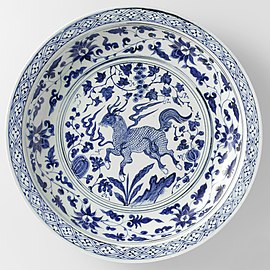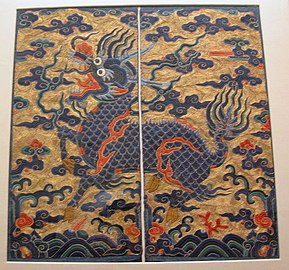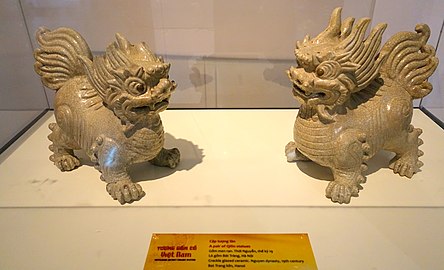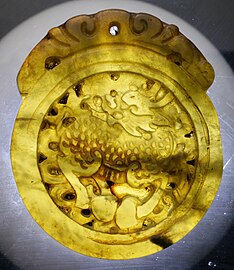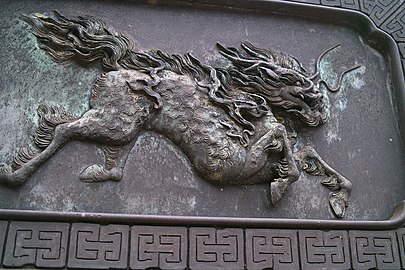Qilin
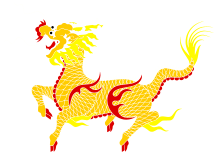 Qing eradepiction of a qilin | |
| Grouping | Legendary creature |
|---|---|
| Sub grouping | Chimera |
| Similar entities | kirin,kỳ lân,gilen |
| First attested | 5th century BCE |
| Country | China |
| Qilin | |||||||||||||||||||||||
|---|---|---|---|---|---|---|---|---|---|---|---|---|---|---|---|---|---|---|---|---|---|---|---|
 "Qilin" in Chinese characters | |||||||||||||||||||||||
| Chinese name | |||||||||||||||||||||||
| Chinese | Kỳ lân | ||||||||||||||||||||||
| |||||||||||||||||||||||
| Vietnamese name | |||||||||||||||||||||||
| Vietnamese Alpha bet | kỳ lân | ||||||||||||||||||||||
| Chữ Hán | Kỳ lân | ||||||||||||||||||||||
| Thai name | |||||||||||||||||||||||
| Thai | กิเลน | ||||||||||||||||||||||
| RTGS | kilen | ||||||||||||||||||||||
| Korean name | |||||||||||||||||||||||
| Hangul | 기린 | ||||||||||||||||||||||
| Hanja | Kỳ lân | ||||||||||||||||||||||
| |||||||||||||||||||||||
| Japanese name | |||||||||||||||||||||||
| Kanji | Kỳ lân | ||||||||||||||||||||||
| Hiragana | きりん | ||||||||||||||||||||||
| |||||||||||||||||||||||
| Manchu name | |||||||||||||||||||||||
| Manchu script | ᡴᡳᠯᡳᠨ | ||||||||||||||||||||||
| Romanization | kilin | ||||||||||||||||||||||
Theqilin(English:/tʃiˈlɪn/chee-LIN;Chinese:Kỳ lân) is alegendaryhoovedchimericalcreature that appears inChinese mythology,and is said to appear with the imminent arrival or passing of asageor illustrious ruler.[1]Qilin are a specific type of thelinmythological family of one-horned beasts. The qilin also appears in the mythologies of other Chinese-influenced cultures.
Origins[edit]

The earliest mention of the mythical qilin is in the poemLân chi ngón chân;Lín zhī zhǐ;'Feet of the Lin' included in theClassic of Poetry(11th – 7th c. BCE).[2][3]Spring and Autumn Annalsmentioned that alin(Lân) was captured in the 14th year of Duke Ai of Lu (Lỗ Ai công) (481 CE);Zuo ZhuancreditedConfuciuswith identifying thelinas such.[4][5][6]

The bisyllabic formqilin(Kỳ lân~Kỳ lân), which carries the same generic meaning aslinalone, is attested in works dated to theWarring States period(475 – 221 BCE).[7]Qidenotes the male andlindenotes the female[8]according toShuowen Jiezi.[9][10]
The legendary image of the qilin became associated with the image of thegiraffein theMing dynasty.[11][12]The identification of the qilin with giraffes began afterZheng He's 15th-centuryvoyage to East Africa(landing, among other places, in modern-daySomalia). The Ming Dynasty bought giraffes from theSomali merchantsalong with zebras, incense, and various other exotic animals.[13]Zheng He's fleet brought back two giraffes toNanjingand they were mistaken by the emperor for the mythical creature, withgerimeaning giraffe inSomali.[citation needed]The identification of qilin with giraffes has had a lasting influence: even today, the same word is used for the mythical animal and the giraffe in both Korean and Japanese.[14]
Axel Schuessler reconstructsOld Chinesepronunciation ofKỳ lânas *gərin.Finnish linguistJuha Janhunententatively compares *gərinto an etymon reconstructed as *kalimV,[15]denoting "whale";and represented in the language isolateNivkhand four different language familiesTungusic,Mongolic,TurkicandSamoyedic,wherein *kalay(ә)ngmeans "whale" (inNenets) and *kalVyǝ"mammoth"(inEnetsandNganasan). As even aborigines "vaguely familiar with the underlying real animals" often confuse the whale, mammoth, and unicorn: they conceptualized the mammoth and whale as aquatic, as well as the mammoth and unicorn possessing a single horn; for inland populations, the extant whale "remains... an abstraction, in this respect being no different from the extinct mammoth or the truly mythical unicorn. "However, Janhunen cautiously remarks that" [t]he formal and semantic similarity between *kilin< *gilin~ *gïlin'unicorn' and *kalimV'whale' (but also Samoyedic *kalay- 'mammoth') is sufficient to support, though perhaps not confirm, the hypothesis of an etymological connection ", and also notes a possible connection between Old Chinese and Mongolian (*)kers~ (*)keris~ (*)kiris"rhinoceros" (Khalkha:хирс).[16]
Description[edit]

Qilin generally haveChinese dragon-like features: similar heads withantlers,eyes with thick eyelashes, manes that always flow upward, and beards. The body is fully or partially scaled and often shaped like an ox, deer, or horse, or more commonly a goat.[17][18]They are always shown with cloven hooves.[19]While dragons in China (and thus qilin) are also most commonly depicted as golden, qilin may be of any color or even various colors, and can be depicted as bejeweled or exhibiting a jewel-like brilliance.[20]
The qilin is depicted throughout a wide range of Chinese art, sometimes with parts of their bodies on fire.[19]
Legends tell that qilin have appeared in thegardenof the legendaryYellow Emperorand in the capital ofEmperor Yao;both events bore testimony to the benevolent nature of the rulers.[18]It has also been told that the birth of the great sageConfuciuswas foretold by the arrival of a qilin.[1]
Qilin as unicorns[edit]

In modern times, the depictions of qilin have often fused with the Western concept of unicorns. Qilin (Kỳ lân) is often translated into English as "unicorn"; the Han dynasty dictionaryShuowen Jiezidescribesqias single-horned,[9]and it can sometimes be depicted as having asingle horn.The translation, however, may be misleading, as qilin can also be depicted as having two horns. In modern Chinese, "one-horned beast" (Một sừng thú;Một sừng thú;Dújiǎoshòu) is used for "unicorns". A number of different Chinese mythical creatures can be depicted with a single horn, and a qilin depicted with one horn may be called a "one-horned qilin" in Chinese.[citation needed]


Nevertheless, the mythical and etymological connections between the creatures have been noted by various cultural studies[14][15][16]and even the Chinese government, which has minted silver, gold, and platinum commemorative coins depicting both archetypal creatures.[21]
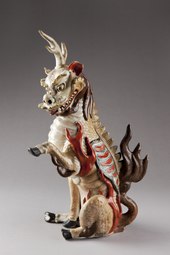
Other cultural representations[edit]
East Asia[edit]
Japan[edit]
Kirin, which has also come to be used as the modern Japanese word for agiraffe,are similar to qilin. Japanese art tends to depict the kirin as more deer-like than inChinese art.Alternatively, it is depicted as a dragon shaped like a deer, but with an ox's tail[22]instead of a lion's tail. They are also often portrayed as partiallyunicorn-like in appearance, but with a backwards curving horn.
Korea[edit]
Girin or kirin (기린) is theKoreanform of qilin. It is described as a maned creature with the torso of adeer,anoxtail with thehoovesof ahorse.The girin were initially depicted as more deer-like, however over time they have transformed into more horse-like.[23]They were one of the four divine creatures along with thedragon,phoenix,andturtle.Girin were extensively used in Korean royal and Buddhist arts.
In modern Korean, the term "girin" is used for "giraffe".
Southeast Asia[edit]
Thailand[edit]
In Thailand, the qilin is known as "gilen"(Thai:กิเลน), and is a member of the pantheon of ThaiHimapantforest mythical animals. It is most probable that the Gilen was introduced into the pantheon under the influence of theTai Yaiwho came down from Southern China to settle inSiamin ancient times, and the legend was probably incorporated into the Himapant legends of Siam in this manner. The Gilen is a mixture of various animals, which come from differing elemental environments, representing elemental magical forces present within each personified creature. Many of the Himapant animals actually represent gods anddevasof the Celestial Realms, andbodhisattvas,who manifest as personifications which represent the true nature of each creature deity through the symbolism of the various body parts amalgamated into the design of the Mythical creature.[24]
InPhra Aphai Mani,the masterpiece epic poem ofSunthorn Phu,a renowned poet of the 18th century. There is a monster that isSudsakorn's steed, one of the main characters in the epic. This creature was called"Ma Nin Mangkorn"(Thai:ม้านิลมังกร,"ceylonite dragon horse" ), it is depicted as it has diamond fangs, ceylonite scales, and a birthmark on the tongue. It was a mixture of horse, dragon, deer antlers, fish scales, andPhaya Naktail, with has black sequins all over. Its appearance resembles a qilin.[25]
Gallery[edit]
-
Qilin statue inPingzhen Xinshi Park,Taoyuan, Taiwan
-
AMing-erapainting of a tribute giraffe, which was thought to be a qilin by court officials, from Bengal
-
Plate with a qilin in the center,Yuan dynasty
-
Embroidered qilin,Qing dynasty
-
Kỳ Lân statues, Bat Trang kiln, Hanoi,Nguyen dynasty,crackle glaze ceramics – at theNational Museum of Vietnamese Historyin Hanoi, Vietnam
-
The logo ofKirin Beerfeatures a kirin (photo taken in Hiroshima, Japan)
-
Qilin pendant
-
Qilin incense burner at theWorld Museum in Liverpool, United Kingdom
-
Qilin incense burner (one of a pair) at the World Museum in Liverpool, United Kingdom
-
Qilin depicted inthe Imperial Encyclopaedia
-
Kirin relief in Tokyo, Japan
-
A winged variant of kirin statue in Tokyo, Japan
-
Qilin (kî-lîn) as an object of worship in Yilan, Taiwan
See also[edit]
- Nian
- Chinthe
- Chimera
- Chinese dragon
- Chinese spiritual world concepts
- Fenghuang
- Four Holy Beasts
- Giraffe
- Japanese dragon
- Kanglasha
- Longma
- Nongshaba
- Pakhangba
- Pixiu
- Poubi Lai
- Questing Beast
- Serpopard
- Shaanxi Kylins
- Shisa
- Singha
- Sin-you
- Sudsakorn(involving a similar creature that aided the protagonist, known as Mar Nin Mang Korn)
- Taoroinai
- Unicorn
- Xiezhi
- Yali
References[edit]
- ^ab"qilin (Chinese mythology)".Encyclopædia Britannica.Retrieved24 July2011.
- ^Classic of Poetry"Airs of Zhou and the South – Lin's Feet"translated by James Legge
- ^Durrant, Li, & Schaberg (translators) (2016).Zuo tradition: Commentary on the Spring and Autumn Annals.Seattle & London: University of Washington Press. p. 1920, n. 292. quote: "It is significant that the earliest source known to mention the lin itself is “Lin zhi zhi” lân chi ngón chân, or “The Foot of the Lin"
- ^Cổ kiến thượng chủ yếu trang trí văn dạng ―― kỳ lân cổ kiến lâm viên kỹ thuật - tác giả: Từ hoa đangArchived30 September 2007 at theWayback Machine
- ^Zuozhuan"Duke Ai – 14th year –jing&zhuan"'
- ^Durrant, Li, & Schaberg (translators) (2016).Zuo tradition: Commentary on the Spring and Autumn Annals.pp. 1919–1921
- ^(2021)."Culture | Four mythical animals in Chinese culture".Publisher:CGTN;quote: "TheFour Auspicious Beasts[Tứ linh;Tứ linh;sì líng:qilin,long,bixi,fenghuang.] are also said to be the rulers of all the other animals. The first known mention of them dates from the Warring States Period (475 BC-221 BC). "Cf.Book of Rites"Li Yun23"quote:" Long lân qui phụng, gọi chi tứ linh. "
- ^ChinaKnowledge.de
- ^abSWJZRadical lộc"quote:" Lân: Đại hươu cái cũng.…… Kỳ: Nhân thú cũng. Mi thân ngưu đuôi, một góc.…… Lân: Mái kỳ cũng. "translation:"Lín( lân ):a large female deer. [...]Qí( kỳ ):a humane beast. Withelaphure's body, ox's tail, and one horn. [...]Lín( lân ):femaleqí."
- ^Parker, Jeannie Thomas (2018)The Mythic Chinese unicorn.Victoria:Friesen Press. p. 44
- ^Này “Lân” phi bỉ “Lân” chuyên gia xưng Satsuma lân đều không phải là trong truyền thuyết kỳ lân
- ^"What Kind of Animal Was the Questing Beast?".Arthuriana.14(2): 66–69. 2004.ISSN1078-6279.JSTOR27870605.
- ^Wilson, Samuel M. (December 1992)."The Emperor's Giraffe".Natural History.Vol. 101, no. 12. pp. 22–25. Archived fromthe originalon 2 December 2008.Retrieved14 April2012.
- ^abParker, J. T.: "The Mythic Chinese Unicorn"
- ^abJanhunen, J. (2011). Unicorn, Mammoth, Whale: mythological and etymological connections of zoonyms in North and East Asia. Linguistics, Archaeology and the Human Past, Occasional Paper, 12, 189–222.
- ^ab"Хирс in Bolor dictionary".Archived fromthe originalon 26 September 2022.Retrieved31 January2019.
- ^"Charger with a qilin, anonymous, c. 1350".Rijksmuseum.Retrieved15 May2022.
- ^abLiscomb, Kathyln (2016). "CHAPTER 9 How the Giraffe Became a Qilin: Intercultural Signification in Ming Dynasty Arts".The Zoomorphic Imagination in Chinese Art and Culture.University of Hawai'i Press. pp. 341–378.ISBN9780824872564.
- ^abBush, Susan (2016). "CHAPTER 2 Labeling the Creatures: Some Problems in Han and Six Dynasties Iconography".The Zoomorphic Imagination in Chinese Art and Culture.University of Hawai'i Press. pp. 76–77.ISBN9780824872564.
- ^Yoshida, Masako (2014)."Trade Stories: Chinese Export Embroideries in the Metropolitan Museum".Metropolitan Museum Journal.49(1): 4–5.doi:10.1086/680031.JSTOR10.1086/680031.S2CID192217718– via JSTOR.
- ^"5 Yuan, China".en.numista.Numista.Retrieved13 December2017.
- ^Griffis, William Elliot (October 2007).The Religions of Japan.Bibliobazaar. p. 39.ISBN978-1-4264-9918-0.
- ^기린: 네이버캐스트
- ^"Taep Payatorn Riding Qilin Himapant Lion Hlang Yant – Nuea Pong Maha Sanaeh Luan – Ajarn Warut – Wat Pong Wonaram".Buddha Magic Multimedia & Publications.Retrieved12 January2016.
- ^Pralongchoeng, Gilen (20 September 2014)."ม้ามังกร"[Dragon horse].Thai Rath(in Thai).Retrieved7 August2021.
External links[edit]
 Media related toQilinat Wikimedia Commons
Media related toQilinat Wikimedia Commons



